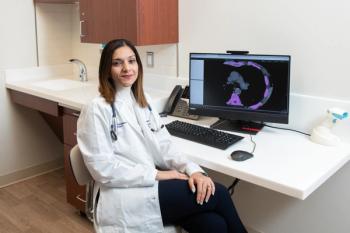
Young Woman With Worsening Dyspnea
A 32-year-old woman complains of dyspnea on exertion that has worsenedover the past 6 to 12 months. The condition makes it difficult for her to climbthe 2 flights of stairs to her apartment when carrying packages, is worse oncold days and, on several occasions recently, has been accompanied by dizziness.She denies cough, sputum production, hemoptysis, and chest pain.
A 32-year-old woman complains of dyspnea on exertion that has worsenedover the past 6 to 12 months. The condition makes it difficult for her to climbthe 2 flights of stairs to her apartment when carrying packages, is worse oncold days and, on several occasions recently, has been accompanied by dizziness.She denies cough, sputum production, hemoptysis, and chest pain.HISTORY
The patient has mild Raynaud phenomenon. She has no family historyof coronary disease. She drinks alcohol occasionally but has never smoked.PHYSICAL EXAMINATION
Vital signs are normal except for heart rate, which is 100 beats perminute at rest. Heart rhythm is regular, with a soft holocystic murmur at thebase. Lungs are clear. No clubbing, cyanosis, or edema is evident.LABORATORY AND IMAGING RESULTS
Electrolyte levels are normal. Serum creatinine level is 0.8 mg/dL, andhemoglobin level is 12.2 g/dL. The antinuclear antibody titer is weakly positiveat 1:80.Chest radiograph is normal. Complete pulmonary function tests show noairflow obstruction and essentially normal lung volumes. The carbon monoxide-diffusing capacity is diminished at 65% of the predicted normal value. Resultsof a ventilation-perfusion scan are normal. A high-resolution CT scan ofthe thorax (with contrast) shows no evidence of pulmonary embolism and nointerstitial abnormalities.Which of the following is the most likely cause of this patient's dyspnea?A. Diaphragm weakness.B. Primary pulmonary hypertension.C. Pulmonary thromboembolic disease.D. Idiopathic pulmonary fibrosis.E. Chronic obstructive pulmonary disease (COPD).CORRECT ANSWER: B
The clinical findings here suggest early pulmonary vasculardisease. The patient's age and lack of smoking historyor cough make COPD (choice E) unlikely. The absenceof any airflow obstruction on pulmonary function testingessentially excludes this diagnosis as the cause of hersymptoms. Pulmonary function testing also reveals normallung volumes. This finding--together with the normalchest radiograph and high-resolution CT scan--rulesout diaphragm weakness (choice A) and pulmonary fibrosis(choice D) on both anatomic and physiologic grounds.Both these conditions behave as restrictive disorders.There are 2 main types of pulmonary vasculardisease:
- Primary pulmonary hypertension.
- Thromboembolic disease.
Pulmonary embolism (choice C) can be reasonablyexcluded on the basis of the CT findings. Although pulmonaryangiography would definitively rule out thromboembolism,the normal ventilation-perfusion scan andhigh-resolution CT scan constitute a strong argumentagainst this diagnosis.Thus, this patient likely has pulmonary vasculardisease caused by primary pulmonary hypertension.Primary pulmonary hypertension is a relatively raredisease, which most often occurs in young and middleagedwomen. It results from increased pressure in thepulmonary vasculature that has no known secondarycause (for example, pulmonary thromboembolism;congenital heart disease with shunting; advancedCOPD; or other vascular diseases, such as scleroderma).This patient's age (32 years), sex (female),and insidious onset of symptoms are consistentwith--and, in fact, typical of--primary pulmonaryhypertension.
Symptoms of primary pulmonary hypertension.
A typical early symptom is progressive dyspnea on exertion,which can be quantitated as the farthest distance onecan walk without stopping. Later symptoms include:
- Exertional chest pain caused by right ventricular hypertrophyand ischemia.
- Exertional dizziness that is caused by decreased rightventricular output and that results in secondary diminishedleft ventricular filling and ejection.
In advanced cases, overt syncope occurs. This seriouscomplication connotes a poor prognosis. Symptomsthat are significantly absent are cough and hemoptysis.Other vascular conditions (for example, Raynaud phenomenon)are seen in about 10% of patients. Classic physicalfindings include a loud P
2
; the presence of an S
4
; and, inadvanced cases, stigmata of right ventricular failure, suchas ascites, edema, and neck vein distention.
1
Prognosis and treatment.
Until recently, the prognosisfor patients with primary pulmonary hypertension wasextremely grim and included inexorable progression ofsymptoms, development of right ventricular failure, andeventually death. The condition remains an indication forheart-lung transplantation, and early referral to a transplantationcenter is an important component of management.Vasodilation with prostacyclin analogs such as epoprostenolhas recently been shown to significantly reduce pulmonaryvascular pressure, diminish symptoms and morbidity,and prolong life in a meaningful percentage of patients.It has become a standard treatment that should betried before transplantation.
2,3
Outcome of this case.
The patient underwent aright heart catheterization, which confirmed pulmonaryhypertension (pulmonary artery pressure, 67 mm Hg).The absence of thromboembolic disease and the lack ofresponse to nitrous oxide, which implies the presence ofpulmonary vascular intima proliferation, confirmed primarypulmonary hypertension. A trial of prostacyclin vasodilationtherapy was begun. The patient will also be referredto a transplantation center for evaluation.
References:
REFERENCES:
1.
Gaine G. Pulmonary hypertension.
JAMA.
2000;284:3160-3168.
2.
Olschewski H, Simonneau G, Galie N, et al. Inhaled iloprost for severe pulmonaryhypertension.
N Engl J Med.
2002;347:322-329.
3.
McLaughlin VV, Genthner DE, Panella MM, Rich S. Reduction in pulmonaryvascular resistance with long-term epoprostenol (prostacyclin) therapy in primarypulmonary hypertension.
N Engl J Med.
1998;338:273-277.
Newsletter
Enhance your clinical practice with the Patient Care newsletter, offering the latest evidence-based guidelines, diagnostic insights, and treatment strategies for primary care physicians.




























































































































































































































































































